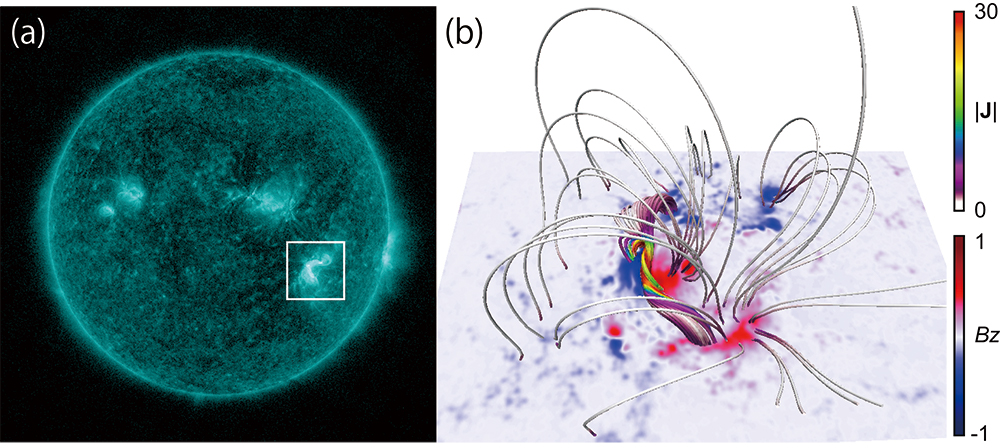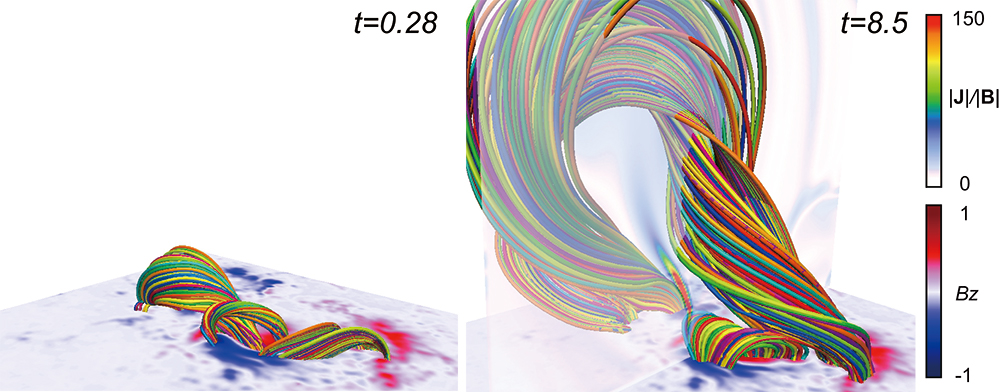Satoshi Inoue (Nagoya university)
The solar active region (AR) 12673, which is surrounded by a white square shown in Figure 1a, produced large solar flares multiple times. Among these flares, in particular, the X9.3 flare observed on September 6 2017 was largest solar flare in the solar cycle 24. According to this flare, huge amount of the coronal plasma and magnetic fields erupted into the interplanetary space, which gave much influence on the magnetosphere and ionosphere.
In this study, we numerically investigated the three-dimensional (3D) magnetic field of AR12673, the initiation and dynamics of the erupting magnetic fields associated with the X9.3 solar flare. We first extrapolated the 3D magnetic field based on the photospheric magnetic field under a nonlinear force-free field (NLFFF: See Science Nuggets No.7) approximation. Next we performed a magnetohydrodynamic (MHD) simulation using the extrapolated magnetic field as the initial condition.
As shown in Figure 1b, we found that the magnetic flux rope (MFR), which is a bundle of the twisted lines, exists in the north-south direction. Since the MFR has strong current density, it can accumulate the free magnetic energy to produce the solar flare. Figure 2 shows results of the MHD simulation. We first found that the multiple MFRs exit along the polarity inversion line at early time. Once part of the MFRs loses the stability or equilibrium, we found that the large and coherent MFR can be formed through a reconnection among the pre-erupting MFRs. Since the current sheet and post-flare loops are formed under the erupting MFR, this simulation result well explains the standard CSHKP flare model. We further found the rotation of the erupting MFR. Therefore we suggest that this rotation might be related to formation of the southward magnetic field which gave much influence on the Geospace.

Figure:1(a) Extreme-UV image of whole Sun observed at AIA 131 Å before the X9.3 flare. The region enclosed by a square corresponds to the active region 12673. (b) Three-dimensional magnetic fields extraolated from the photospheric magnetic field numeircally under a nonlinear force-free field approximation. The photospheric magnetic field corresponds to prior to the flare, which is taken by SDO/HMI. The lines correspond to the magnetic field lines which are drwan by the absolute value of the electic current density.

Figure2: A temporal evolution of the erupting magnetic flux rope. The lines correspond to the field lines and the distribution of |J|/|B| is plotted on the vertical cross section.
Satoshi Inoue, Daikou Shiota, Yumi Bamba, & Sung-Hong Park, “Magnetohydrodynamic Modeling of a Solar Eruption Associated with an X9.3 Flare Observed in the Active Region 12673”, The Astrophysical Journal Volume 867, Issue 1, article id.83 (2018)
http://iopscience.iop.org/article/10.3847/1538-4357/aae079/meta
